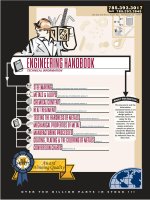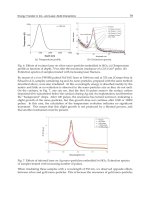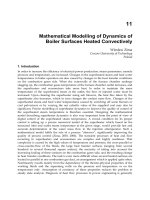engineering materials 2e volume1 potx
Bạn đang xem bản rút gọn của tài liệu. Xem và tải ngay bản đầy đủ của tài liệu tại đây (13.21 MB, 322 trang )
SECOND EDITION
'A'
AN INTRODUCTION
TO
THEIF;
PROPERTIES
&
APPLICATIONS
Michael
F
Ashby. David
R
H
Jones
Engineering Materials
1
An lntroduction
to
their Properties
and
Applications
Other titles
of
interest
Ashby
Ashby and Jones
Brydson
Charles and Crane
Crawford
Hull and Bacon
Jones
Neale
Shreir et al.
Smallman and
Bishop
Smith
Materials Selection in Mechanical Design
Engineering Materials 2
Plastics Materials, 6th Edition
Selection and Use
of
Engineering Materials, 2nd Edition
Plastics Engineering, 2nd Edition
Introduction to Dislocations, 3rd Edition
Engineering Materials
3
Tribology Handbook, 2nd Edition
Corrosion, 3rd Edition
Metals and Materials
The Language
of
Rubber
Engineering
Materials
1
An
Introduction to their Properties
and
Applications
Second Edition
by
Michael
F.
Ashby
and
David
R.
H.
Jones
Department
of
Engineering, University
of
Cambridge,
UK
UTTERWORTH
EINEMANN
OXFORD AMSTERDAM BOSTON LONDON NEW YORK
PARIS
SAN DIEGO SAN FRANCISCO SINGAPORE SYDNEY TOKYO
Butterworth-Heinemann
An imprint of Elsevier Science
Linacre House, Jordan Hill, Oxford OX2 8DP
225 Wildwood Avenue, Wobum, MA 01801-2041
First published 1980
Second edition 1996
Reprinted 1997, 1998 (twice), 2000,2001,2002
0
1980, 1996, Michael
F.
Ashby and David R.
H.
Jones. All rights reserved.
The right
of
Author name to
be
identified as the author of this work has
been
asserted in accordance with the Copyright, Designs and Patents Act 1988
No
part
of
this publication may
be
reproduced in any material form (including
photocopying or storing in any medium by electronic means and whether or
not transiently or incidentall to some other use of this publication) without the
written permission of the copyright holder except in accordance with the
provisions of the Copyright, Designs and Patents Act 1988
or
under the terms
of a licence issued by the Copyright Licensing Agency Ltd,
90
Tottenham
Court Road, London, England WIT 4LP. Applications for the copyright
holder’s written permission to reproduce any
part
of
this publication should
be addressed to the publishers
British Library Cataloguing
in
Publication Data
Ashby, Michael
E
Engineering materials.
1.
an introduction to their
properties and applications.
-
2nd. ed.
1. Materials
2.
Mechanics
I.
Title
11.
Jones, David R. H. (David Rayner Hunkin),
1945-620.1’1
ISBN
0
7506 3081 7
Library
of
Congress Cataloguing in Publication Data
Ashby, Michael
E
Engineering materials. 1. an introduction to their properties and
applicationsby Michael
F.
Ashby and David R. H. Jones
-
2nd. ed.
p. cm.
Rev.ed
of
Engineering materials. 1980.
Includes bibliographical references and index.
ISBN
0
7506 3081 7
1.
Materials.
I.
Jones, David R.
H.
(David Rayner Hunkin),
1945
11. Ashby, M.F. Engineering materials
III.
Title
TA403.A69 96-1677
620.1’1-dc20 CIP
For
information on all Butterworth-Heinemann publications
visit our website at www.bh.com
Typeset by Genesis Typesetting, Rochester, Kent
Printed and bound in Great Britain by
MFG
Books Ltd, Bodmin, Comwall
General introduction
1.
Engineering Materials and their Properties
examples of structures and devices showing how we select the right
material for the
job
3
A.
Price and availability
2.
The Price and Availability
of
Materials
15
what governs the prices of engineering materials, how long will supplies
last, and how can we make the most of the resources that we have?
B.
The elastic moduli
3.
The
Elastic Moduli
27
stress and strain; Hooke’s Law; measuring Young’s modulus; data for
design
4. Bonding Between Atoms
36
the
types
of bonds that hold materials together; why some bonds are
stiff and others floppy
5.
Packing
of
Atoms
in
Solids
45
how atoms are packed in crystals
-
crystal structures, plane (Miller)
indices, direction indices; how atoms are packed in polymers, ceramics
and glasses
6.
The Physical Basis
of
Young’s
Modulus
58
how the modulus is governed by bond stiffness and atomic packing; the
glass transition temperature in rubbers; designing stiff materials
-
man-made composites
7.
Case Studies
of
Modulus-limited Design
66
the mirror for a big telescope; a stiff beam
of
minimum weight;
a
stiff
beam of minimum cost
vi
Contents
C.
Yield strength, tensile strength, hardness and
ductility
8.
The Yield Strength, Tensile Strength, Hardness and Ductility
definitions, stress-strain curves (true and nominal), testing methods,
data
9.
Dislocations and Yielding in Crystals
the ideal strength; dislocations (screw and edge) and how they move to
give plastic flow
10.
Strengthening Methods and Plasticity
of
Polycrystals
solid solution hardening; precipitate and dispersion strengthening;
work-hardening; yield in polycrystals
11.
Continuum Aspects
of
Plastic Flow
the shear yield strength; plastic instability; the formability of metals and
polymers
12.
Case Studies in Yield-limited Design
materials for springs; a pressure vessel of minimum weight; a pressure
vessel of minimum cost; how metals are rolled into sheet
D.
Fast fracture, toughness and fatigue
where the energy comes from for catastrophic crack growth; the
condition for fast fracture; data for toughness and fracture toughness
13.
Fast Fracture and Toughness
14.
Micromechanisms
of
Fast Fracture
ductile tearing, cleavage; composites, alloys
-
and why structures are
more likely to fail in the winter
15.
Fatigue Failure
fatigue testing, Basquin’s Law, Coffin-Manson Law; crack growth rates
for pre-cracked materials; mechanisms
of
fatigue
16.
Case Studies in Fast Fracture and Fatigue Failure
fast fracture of an ammonia tank; how to stop a pressure vessel blowing
up; is cracked cast iron safe?
E.
Creep deformation and fracture
high-temperature behaviour of materials; creep testing and creep curves;
consequences of creep; creep damage and creep fracture
17.
Creep and Creep Fracture
77
93
104
111
119
131
140
146
155
169
Contents
vii
18. Kinetic Theory
of
Diffusion
1
79
Arrhenius's Law; Fick's first law derived from statistical mechanics of
thermally activated atoms; how diffusion takes place in solids
19. Mechanisms
of
Creep, and Creep-resistant Materials 187
metals and ceramics
-
dislocation creep, diffusion creep; creep in
polymers; designing creep-resistant materials
20. The Turbine Blade
-
A Case
Study
in Creep-limited Design
197
requirements of a turbine-blade material; nickel-based super-alloys,
blade cooling; a new generation of materials?
-
metal-matrix composites,
ceramics, cost effectiveness
F.
Oxidation and corrosion
21. Oxidation
of
Materials
the driving force for oxidation; rates of oxidation, mechanisms of
oxidation; data
22. Case Studies in Dry Oxidation
making stainless alloys; protecting turbine blades
23. Wet Corrosion
of
Materials
voltages as driving forces; rates of corrosion; why selective attack is
especially dangerous
24. Case Studies in Wet Corrosion
how to protect an underground pipeline; materials for a light-weight
factory roof; how to make motor-car exhausts last longer
G.
Friction, abrasion and wear
25. Friction and Wear
surfaces in contact; how the laws
of
friction are explained
by
the
asperity-contact model; coefficients of friction; lubrication; the adhesive
and abrasive wear of materials
26. Case Studies in Friction and Wear
the design
of
a
journal bearing; materials for
skis
and sledge runners;
'non-skid' tyres
211
219
225
232
241
250
viii
Contents
Final
case
study
27.
Materials and Energy in Car Design
the selection and economics
of
materials
for
automobiles
Appendix
1
Examples
Appendix
2
Aids and Demonstrations
Appendix
3
Symbols and Formulae
261
273
290
297
Index
303
General introduction
To
the student
Innovation in engineering often means the clever use of a new material
-
new to a
particular application, but not necessarily (although sometimes) new in the sense of
‘recently developed’. Plastic paper clips and ceramic turbine-blades both represent
attempts to do better with polymers and ceramics what had previously been done well
with metals. And engineering disasters are frequently caused by the misuse of
materials. When the plastic tea-spoon buckles as you stir your tea, and when a fleet
of
aircraft is grounded because cracks have appeared in the tailplane, it is because the
engineer who designed them used the wrong materials or did not understand the
properties of those used.
So
it is vital that the professional engineer should know how
to select materials which best fit the demands of the design
-
economic and aesthetic
demands, as well as demands of strength and durability. The designer must
understand the properties of materials, and their limitations.
This book gives a broad introduction to these properties and limitations. It cannot
make you
a
materials expert, but it can teach you how to make a sensible choice of
material, how to avoid the mistakes that have led to embarrassment or tragedy in the
past, and where to turn for further, more detailed, help.
You will notice from the Contents list that the chapters are arranged in
groups,
each
group describing a particular class of properties: the elastic modulus; the fracture
toughness; resistance to corrosion; and
so
forth. Each such group
of
chapters starts by
defining the property,
describing how it is
measured,
and giving a table of
data
that we use
to solve problems involving the selection and use of materials. We then move on to the
basic science
that underlies each property, and show how we can use this fundamental
knowledge to design materials with better properties. Each group ends with a chapter
of
case studies
in which the basic understanding and the data for each property are
applied to practical engineering problems involving materials. Each chapter has
a
list
of
books for
further reuding,
ranked
so
that the more elementary come first.
At the end of the book you will find sets of examples; each example is meant to
consolidate or develop a particular point covered in the text. Try to do the examples
that derive from a particular chapter whilesthis is still fresh in your mind. In this way
you will gain confidence that you are on top of the subject.
No
engineer attempts to learn or remember tables or lists
of
data for material
properties. But you
should
try to remember the broad orders-of-magnitude of these
quantities. All grocers know that ’a kg of apples is about
10
apples’
-
they still weigh
them, but their knowledge prevents them making silly mistakes which might cost them
money. In the same way, an engineer should know that ’most elastic moduli lie between
1
and
lo3
GN
m-2;
and are around
102GN
mW2 for metals’
-
in any real design
you
need
an accurate value, which you can get from suppliers’ specifications; but an order-of-
2
Engineering Materials
1
magnitude knowledge prevents you getting the units wrong, or making other silly, and
possibly expensive, mistakes. To help you in this, we have added at the end of the book
a list of the important definitions and formulae that you should know, or should be able
to derive, and a summary of the orders-of-magnitude of materials properties.
To the
lecturer
This book is
a
course in Engineering Materials for engineering students with no
previous background in the subject. It is designed to link up with the teaching
of
Design, Mechanics and Structures, and to meet the needs of engineering students in the
1990s for a first materials course, emphasising applications.
The text is deliberately concise. Each chapter is designed to cover the content of one
50-minute lecture, twenty-seven in all, and allows time for demonstrations and
illustrative slides. A list of the slides, and a description of the demonstrations that we
have found appropriate to each lecture, are given in Appendix 2. The text contains sets
of worked case studies (Chapters 7, 12, 16, 20, 22, 24, 26 and 27) which apply the
material of the preceding block of lectures. There are examples for the student at the
end of the book; worked solutions are available separately from the publisher.
We have made every effort to keep the mathematical analysis as simple as possible
while still retaining the essential physical understanding, and still arriving at results
which, although approximate, are useful. But we have avoided mere description: most
of the case studies and examples involve analysis, and the use of data, to arrive at
numerical solutions to real or postulated problems. This level of analysis, and these
data, are of the type that would be used in a preliminary study for the selection of a
material or the analysis of a design (or design-failure). It is worth emphasising to
students that the next step would be a detailed analysis, using
more
precise
mechanics
(from the texts given as 'further reading') and
data from the supplier
of
the material
or
from
in-house testing.
Materials data are notoriously variable. Approximate tabulations like
those given here, though useful, should never be used for final designs.
Chapter
1
Engineering materials and their properties
Introduction
There are, it is said, more than
50,000
materials available to the engineer. In designing
a
structure or device, how is the engineer to choose from this vast menu the material
which best suits the purpose? Mistakes can cause disasters. During World War 11, one
class of welded merchant ship suffered heavy losses, not by enemy attack, but by
breaking in half at sea: the
fracture toughness
of the steel
-
and, particularly, of the welds
was too low. More recently, three Comet aircraft were lost before it was realised that the
design called for a
fatigue strength
that
-
given the design
of
the window frames
-
was
greater than that possessed by the material. You yourself will be familiar with poorly-
designed appliances made of plastic: their excessive 'give' is because the designer did
not allow for the low
modulus
of
the polymer. These bulk properties are listed in Table
1.1,
along with other common classes of property that the designer must consider when
choosing a material. Many of these properties will be unfamiliar to
you
-
we will
introduce them through examples in this chapter. They form the basis
of
this first
course on materials.
In this first course, we shall also encounter the
classes
of
materials
shown in Table
1.2.
More engineering components are made of
metals and alloys
than of any other class of
solid. But increasingly,
polymers
are replacing metals because they offer a combination
of properties which are more attractive to the designer. And if you've been reading the
newspaper, you will know that the new
ceramics,
at present under development world
wide, are an emerging class of engineering material which may permit more efficient
heat engines, sharper knives, and bearings with lower friction. The engineer can
combine the best properties of these materials to make
composites
(the most familiar is
fibreglass) which offer specially attractive packages of properties. And
-
finally
-
one
should not ignore
natural maferials
like wood and leather which have properties which
-
even with the innovations of today's materials scientists
-
are hard to beat.
In this chapter we illustrate, using a variety of examples, how the designer selects
materials
so
that they provide him or her with the properties needed. As a first
example, consider the selection of materials for a
Plastic-handled screwdriver
A
typical screwdriver has a shaft and blade made of a high-carbon steel, a metal. Steel
is chosen because its
modulus
is high. The modulus measures the resistance of the
material to elastic deflection or bending. If you made the shaft out of a polymer like
polyethylene instead, it would twist far too much.
A
high modulus is one criterion in
4
Engineering
Materials
1
Table
1.1
Classes
of
property
Economic
General Physical
Mechanical
Thermal
Electrical and
Magnetic
Environmental
Interaction
Production
Aesthetic
Price and availability
Recyclability
Density
Modulus
Yield and tensile strength
Hardness
Fracture toughness
Fatigue strength
Creep strength
Damping
Thermal conductivity
Specific
heat
Thermal expansion coefficient
Resistivity
Dielectric constant
Magnetic permeability
Oxidation
Corrosion
Wear
Ease
of
manufacture
Joining
Finishing
Colour
Texture
Feel
the selection of a material for this application. But it is not the only one. The shaft must
have a high
yield strength.
If
it does not, it will bend or twist if you turn it hard (bad
screwdrivers do). And the blade must have a high
hardness,
otherwise it will be
damaged by the head of the screw. Finally, the material
of
the shaft and blade must not
only do all these things, it must also resist fracture
-
glass, for instance, has a high
modulus, yield strength and hardness, but it would not be a good choice for this
application because it is
so
brittle. More precisely, it has a very low
fracfure
toughness.
That of the steel is high, meaning that it gives a bit before it breaks.
The handle of the screwdriver is made of a polymer
or
plastic, in this instance
polymethylmethacrylate, otherwise known as PMMA, plexiglass or perspex. The
handle has a much larger section than the shaft,
so
its twisting, and thus its modulus,
is less important.
You
could not make it satisfactorily out of a soft rubber (another
polymer) because its modulus is much too low, although a thin skin of rubber might be
useful because its
friction coefficient
is high, making it easy
to
grip. Traditionally, of
course, tool handles were made of another natural, polymer
-
wood
-
and, if you
measure importance by the volume consumed per year, wood
is
still by far the most
important polymer available to the engineer. Wood has been replaced by PMMA
Engineering materials and their properties
5
because
PMMA
becomes
soft
when hot and can be moulded quickly and easily to its
final shape. Its
ease offabrication
for this application is high. It is also chosen for aesthetic
reasons: its
appearance,
and feel or
texture,
are right; and its
density
is low,
so
that the
screwdriver is not unnecessarily heavy. Finally,
PMMA
is cheap, and this allows the
product to be made at a reasonable
price.
Now a second example, taking us from low technology to the advanced materials
design involved in the turbofan aero-engines which power large planes. Air is propelled
Table
1.2
Classes
of
materials
Metals and alloys
Iron and
steels
Aluminium and
its
alloys
Copper and
its
alloys
Nickel and
its
alloys
Titanium and
its
alloys
Polyethylene
(PE)
Polymethylmethacrylate (Acrylic and
PMMA)
Nylon, alias Polyamide
(PA)
Polystyrene
(PS)
Polyurethane (PU)
Polyvinylchloride
(WC)
Polyethylene tetraphthalate
(PET)
Polyethylether Ketone
(PEEK)
Epoxies
(EP)
Elastomers, such as natural rubber
(NR)
Ceramics and glasses'
Alumina (AI2O3, emery, sapphire)
Magnesia
(MgO)
Silica
(SOz)
glasses and silicates
Silicon carbide
(Sic)
Silicon nitride
(Si3N4)
Cement and concrete
Fibreglass
(GFRP)
Carbon-fibre reinforced polymers
(CFRP)
Filled
polymers
Cermets
Natural materials
Wood
Leather
Cotton/wool/silk
Bone
fo/ymers
Composites
*Ceramics are crystalline, inorganic, non-metals.
Glasses are non-crystalline (or amorphous) solids. Most
engineering glasses are non-metals, but a range
of
metallic glasses with useful properties
is
now available.
6
Engineering
Materials
1
CFRP GFRP
Polymers
Filled polymers
past (and into) the engine by the turbofan, providing aerodynamic thrust. The air is
further compressed by the compressor blades, and is then mixed with fuel and burnt in
the combustion chamber. The expanding gases drive the turbine blades, which provide
power to the turbofan and the compressor blades, and finally pass out of the rear of the
engine, adding to the thrust.
The
turbofan blades
are made from a titanium alloy, a metal. This has a sufficiently
good modulus, yield strength, and fracture toughness. But the metal must also resist
fatigue
(due to rapidly fluctuating loads),
surface wear
(from striking everything from
water droplets to large birds) and
corrosion
(important when taking off over the sea
because salt spray enters the engine). Finally,
density
is extremely important for obvious
reasons: the heavier the engine, the less the pay-load the plane can carry. In an effort to
reduce weight even further, composite blades made of carbon-fibre reinforced
polymers
-
CFRP
-
with density less than one-half of that of titanium, have been tried.
But
CW,
by itself is simply not tough enough for turbofan blades
-
a 'bird strike'
demolishes a
CFRP
blade. The problem can be overcome by
cladding,
giving the
CFRP
a metallic leading edge.
Turning to the
turbine blades
(those in the hottest part of the engine) even more
material requirements must be satisfied. For economy the fuel must be burnt at as high
a temperature as possible. The first row of engine blades (the
'HP1'
blades) runs at
metal temperatures of about
950°C,
requiring resistance to
creep
and to
oxidation.
Nickel-based alloys of complicated chemistry and structure are used for this
exceedingly stringent application; they are one pinnacle of advanced materials
technology.
An example which brings in somewhat different requirements is the
spark plug
of an
internal combustion engine. The
spark electrodes
must resist
themal fatigue
(from rapidly
fluctuating temperatures),
wear
(caused by spark erosion) and
oxidation
and
corrosion
from hot upper-cylinder gases containing nasty compounds of sulphur, and lead (from
anti-knock additives). Tungsten alloys are used for the electrodes because they have the
desired properties.
The
insulation
around the central electrode is an example of a non-metallic material
-
in this case, alumina, a ceramic. This is chosen because of its electrical insulating
properties and because it also has good thermal fatigue resistance and resistance to
corrosion and oxidation (it is an oxide already).
Ceramics
and
glasses
Engineering materials and their properties
7
The use of non-metallic materials has grown most rapidly in the consumer industry.
Our next example, a sailing cruiser, shows just how extensively polymers and man-
made composites and fibres have replaced the 'traditional' materials of steel, wood and
cotton.
A
typical cruiser has a
hull
made from
GFRP,
manufactured as a single
moulding;
GFRP
has good
appearance
and, unlike steel or wood, does not rust or
become eaten away by Terido worm. The
mast
is made from aluminium alloy, which is
lighter for a given strength than wood; advanced masts are now being made by
reinforcing the alloy with carbon or boron fibres (man-made composites). The sails,
formerly of the natural material cotton, are now made from the polymers nylon,
Terylene or Kevlar, and, in the running rigging, cotton ropes have been replaced by
polymers also. Finally, polymers like
PVC
are extensively used for things like fenders,
anoraks, bouyancy bags and boat covers.
Three man-made composite materials have appeared in the items we have
considered
so
far: glass-fibre reinforced polymers
(GFRP);
the much more expensive
carbon-fibre reinforced polymers
(CFRP);
and the still
more
expensive boron-fibre
reinforced alloys
(BFRP).
The range of composites is a large and growing one (Fig.
1.1);
during the next decade composites will, increasingly, compete with steel and
aluminium in many traditional
uses
of these metals.
So
far we have introduced the mechanical and physical properties of engineering
materials, but we have yet to discuss a consideration which is often of overriding
importance: that of
price and availability.
Table
1.3
shows a rough breakdown of material prices. Materials for large-scale
structural use
-
wood, cement and concrete, and structural steel
-
cost between
US50
and
US500 (US$75
and
US$750)
per tonne. There are many materials which
have all the other properties required of a structural material
-
nickel or titanium,
for example
-
but their use in this application is eliminated by their price.
The value that is added during light-and medium-engineering work is larger, and
this usually means that the economic constraint on the choice
of
materials is less
severe
-
a far greater proportion of the cost of the structure is that associated with
labour or with production and fabrication. Stainless steels, most aluminium alloys
and most polymers cost between
W500
and
UK€5000 (US$750
and
US$7500)
per
Table
1.3
Class
of
use
Basic construction
Medium and light
engineering
Special materials
Precious
metals,
etc.
Industrial diamond
Material Price
per
tonne
Wood,
concrete, structural
steel
UK€50-500
US$75-750
Metals,
alloys and polymers for
um-5,000 US$750-7,500
Turbine-blade alloys, advanced
uK€5,o0o-5o,o00
US$7,500-75,000
aircraft, automobiles, appliances,
etc.
composites
(CFRP,
BRFP),
etc.
Sapphire bearings, silver contacts,
UK€50,OOO-1
Om
US$75,000-l5m
gold microcircuits
Cutting and polishing
tools
>UKEl
Om
>US$15m
8
Engineering Materials
1
Fig.
1.2.
The wooden bridge at Queens' College,
a
1
902
reconstruction
of
the original 'mathematical' bridge
built in 1749
to
William Etheridge's design.
Fig.
1.3.
Clare Bridge, built in 1640,
is
Cambridge's oldest surviving bridge;
it
is reputed to have been an
escape-route from the college in times
of
plague.
Engineering materials and their properties
9
I
Fig.
1.4.
Magdalene Bridge built in
1823
on the site
of
the ancient Saxon bridge over the Cam The present
cast-iron arches carried, until recently, loads
far
in excess
of
those envisaged by the designers. Fortunately, the
bridge has now undergone a well-earned restoration
Fig.
1.5.
A
typical hentieth-century mild-steel bridge; a convenient crossing to the Fort
St
George inn!
10
Engineering Materials
1
Fig.
1.6.
The reinforced concrete footbridge in Garret Hostel lane. An inscription carved nearby reads:
'This
bridge was given in
1960
by
the Trusted family members
of
Trinity Hall. It was designed by Timothy Guy
MORGAN
an undergraduate
of
Jesus
College
who died in that year.'
INTRINSIC ATTRIBUTIVE
m
1
Bulk mechanical
properties
mechanical ease
of
manufacture,
properties fabrication,
Surface
properties
Aesthetic
properties-
appearance,
Y
texture, feel
Fig.
1.7.
How the properties of engineering materials affect the way in which products are designed.
Engineering materials and their properties
11
tonne. It is in this sector of the market that the competition between materials is most
intense, and the greatest scope for imaginative design exists. Here polymers and
composites compete directly with metals, and new structural ceramics (silicon
carbide and silicon nitride) may compete with both in certain applications.
Next there are the materials developed for high-performance applications, some of
which we have mentioned already: nickel alloys (for turbine blades), tungsten (for
sparking-plug electrodes) and special composite materials such as CFRP. The price of
these materials ranges between uKE5000 and
UK€50,000
(US$7500 and US$75,OOO) per
tonne. This the rkgime of high materials technology, actively under reseach, and in
which major new advances are continuing to be made. Here, too, there is intense
competition from new materials.
Finally, there are the so-called precious metals and gemstones, widely used in
engineering: gold for microcircuits, platinum for catalysts, sapphire for bearings,
diamond for cutting tools. They range in price from UE50,OOO (US$75,000) to well over
UKElOOm (US$150m) per tonne.
As
an example of how price and availability affect the choice of material for a
particular job, consider how the materials used for building bridges in Cambridge have
changed over the centuries.
As
our photograph of Queens’ Bridge (Fig.
1.2)
suggests,
until 150 years or
so
ago wood was commonly used for bridge building. It was cheap,
and high-quality timber was still available in large sections from natural forests. Stone,
too, as the picture of Clare Bridge (Fig. 1.3) shows, was widely used. In the eighteenth
century the ready availability of cast-iron, with its relatively low assembly costs, led to
many cast-iron bridges of the type exemplified by Magdalene Bridge (Fig. 1.4).
Metallurgical developments of the later nineteenth century allowed large mild-steel
structures to be built (the Fort St. George Footbridge, Fig. 1.5). Finally, the advent of
cheap reinforced concrete led to graceful and durable structures like that of the Garret
Hostel Lane bridge (Fig.
1.6).
This evolution clearly illustrates how availability
influences the choice of materials. Nowadays, wood, steel and reinforced concrete are
often used interchangeably in structures, reflecting the relatively small
price
differences
between them. The choice of which of the three materials to use is mainly dictated by
the kind of structure the architect wishes to build: chunky and solid (stone),
structurally efficient (steel), slender and graceful (pre-stressed concrete).
Engineering design, then, involves many considerations (Fig. 1.7). The choice of a
material must meet certain criteria on bulk and surface properties (strength and
corrosion resistance, for example). But it must also be easy to fabricate;
it
must appeal
to potential consumers; and it must compete economically with other alternative
materials. In the next chapter we consider the economic aspects of this choice, returning
in
later chapters to a discussion of the other properties.
Further
reading
J.
E.
Gordon,
The New Science
of
Strong Materials, or
Why
You Don‘t
Fall
Through the Floor,
Penguin
Books,
London,
1976,
(an excellent general introduction to materials).
K.
E.
Easterling,
Tomorrow’s Materials,
Institute of Materials, London,
1987,
(an entertaining
introduction focussing on the use of high-tech. materials in aerospace, electronics and sporting
goods).
A.
Price and availability
Chapter
2
The price and availability
of
materials
Introduction
In the first chapter we introduced the range of properties required of engineering
materials by the design engineer, and the range of materials available to provide these
properties. We ended by showing that the
price
and
availability
of materials were
important and often overriding factors in selecting the materials for a particular job. In
this chapter we examine these economic properties of materials in more detail.
Data
for
material prices
Table 2.1 ranks materials by their cost per unit weight:
UKf
per tonne (i.e.
1000
kg) in the
second column,
US$
per tonne in the third. The most expensive materials
-
diamond,
platinum, gold -are at the top. The cheapest
-
cast iron, wood, cement
-
are at the bottom.
Such data are obviously important in choosing a material. How do we keep informed
about materials prices change and what controls them?
The
Financial Times
and the
Wall Street Journal
give some, on a daily basis. Trade
supply journals give more extensive lists of current prices.
A
typical such journal is
Procurement
Weekly,
listing current prices of basic materials, together with prices 6
months and a year ago. All manufacturing industries take this or something equivalent
-
the workshop in your engineering department will have it
-
and it gives a guide to
prices and their trends. Figure 2.1 shows the variation in price of two materials
-
copper and rubber
-
between September 1993 and May 1994. It illustrates two points.
First, there is a long-term upward movement in material prices. Thirty years ago,
copper was UKf200 (US$300) per tonne and rubber was UKE60 (US$90) per tonne; now
they are more than five times this price.
Second, there are considerable short-term fluctuations in material prices. Copper
dropped
15%
in the month of September 1993; gold, in the same period, rose 38%.
Aluminium changed in price by nearly 10% in a single day in December 1993. These are
large changes, important to the purchaser of materials.
The short-term price fluctuations have little to do with the real scarcity or abundance
of materials. They are caused by small differences between the rate of supply and
demand, much magnified by speculation in commodity futures. The volatile nature of
the commodity market can result in large changes over a period of a few days
-
that
is
one reason speculators are attracted to it
-
and there is very little that an engineer can
do to foresee or insure against these changes. Political factors are also extremely
important
-
a scarcity
of
cobalt in
1978
was due to the guerilla attacks on mineworkers
in Zaire, the world’s principal producer of cobalt; the low price of aluminium and of
16 Engineering Materials
1
Table
2.1
Price per tonne (May
1994)
Material
UKf/tonne US$/tonne
Diamonds, industrial
Platinum
Gold
Silver
CFRP (mats.
70%
of cost; fabr.
30%
of cost)
Cobalt/tungsten carbide cermets
Tungsten
Titanium
allor
a1 oys
Nickel alloys
Polyimides
Silicon carbide (fine ceramic)
Magnesium alloys
Nylon
66
Polycarbonate
PMMA
Magnesia, MgO (fine ceramic)
Alumina, A1203 (fine ceramic)
Tool
steel
GFRP (mats.
60%
of cost; fabr.
40%
of cost)
Stainless steels
Copper, worked (sheets,
tubes,
bars)
Copper, ingots
Aluminium alloys, worked (sheet, bars)
Aluminium ingots
Brass, worked (sheet, tubes, bars)
Brass, ingots
EPOXY
Polyester
Glass
Foamed polymers
Zinc, worked (sheet, tubes,
bars)
Zinc, ingots
Lead, worked (bars, sheet,
tube)
Lead,
ingots
Natural rubber
Polypropylene
Polyethylene, high density
Polystyrene
Hard woods
Polyethylene, low density
Polyvinyl chloride
Plywood
Low-alloy steels
Mild
steel, worked (angles, sheet, bars)
Cast iron
Iron, ingots
Soft
woods
Concrete, reinforced (beams, columns, slabs)
Fuel oil
Cement
Cool
4-6
x
lo8
5.0-5.6
X
lo6
1.2-1.5
x
107
3.0-4.5
x
lo5
3.5-8
x
lo4
3.7-5.0
x
lo4
1.6-2.4
x
1
O4
3.2-4.0
x
lo4
5.1-6.0
x
lo4
2.2-2.5
x
lo4
1.3-1.5
X
1O4
1
s-2.5
x
104
2200-3300
2500-5400
2750-3200
1800-2500
5000-1 5000
8000-1 2000
1200-2000
1300-3000
1800-2300
1200-1 250
1150-1200
910-1200
91 0-930
1200-1 A00
1100-1400
2500-3200
1200-1 800
680-1 200
1
100-3000
1
000-1300
1000-1100
550-800
500-550
450-1 500
500-700
550-600
600-800
400-1 000
600-650
450-1 200
300-1 000
320-450
250-350
200-350
180-200
100-300
128-1 80
100-1 40
50-60
50-58
6-9
x
lo8
7.5-8.4
X
lo6
1.8-2.25
x
lo7
4.5-6.75
x
lo5
5.25-12
x
lo4
1.95-2.25
x
lo4
2.4-3.6
x
lo4
4.8-6.0
x
lo4
7.6-9.0
x
lo4
2.25-3.75
x
lo4
5.55-7.5
x
io4
3.3-3.75
x
104
3300-4950
3750-8100
41 25-4800
2700-3750
7500-22500
12000-1 8000
1800-3000
1950-4500
2700-3450
1800-1 875
1725-1 800
1365-1 800
1365-1 395
1800-2100
1650-2100
3750-4800
1800-2700
1020-1 800
1650-4500
1500-1 950
1500-1 650
825-1 200
750-825
675-2250
750-1
050
8 25- 900
900-1
200
600-1 500
900-975
675-1 800
450-1
500
480-675
375-525
300-525
270-300
150-450
192-270
150-21
0
75-90
75-87









